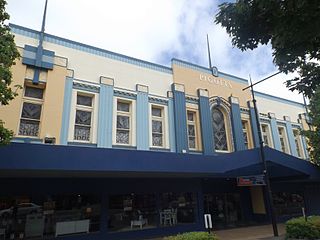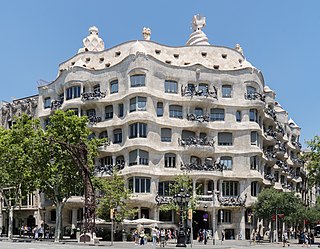
The trunk or boot of a car is the vehicle's main storage or cargo compartment, often a hatch at the rear of the vehicle. It can also be called a tailgate.

Self storage is an industry that rents storage space, also known as "storage units," to tenants, usually on a short-term basis. Self-storage tenants include businesses and individuals.

The X class is a class of diesel locomotives built by English Electric for the Tasmanian Government Railways between 1950 and 1952. They were the first class of diesel locomotive to enter mainline service on a Government-owned railway in Australia.

Buda Castle is the historical castle and palace complex of the Hungarian Kings in Budapest. It was first completed in 1265, although the massive Baroque palace today occupying most of the site was built between 1749 and 1769. The complex in the past was referred to as either the Royal Palace or the Royal Castle. The castle now houses the Hungarian National Gallery and the Budapest Historical Museum.

Queen's Quay Terminal is a condominium apartment, office and retail complex in the Harbourfront neighbourhood in Toronto, Ontario, Canada. It was originally built in 1927 as a marine terminal with office, warehouse and cold-storage facilities. When shipping to Toronto declined in the 1960s and 1970s, the building was bought by the Government of Canada to be repurposed along with a section of the industrial waterfront. The Terminal Building itself was rebuilt in the 1980s with the addition of four floors of residential above the original facility, which was converted into retail and office uses. The cold storage wing was demolished and its plant building became The Power Plant gallery and Harbourfront Centre Theatre.

A horse-drawn vehicle is a piece of equipment pulled by one or more horses. These vehicles typically have two or four wheels and were used to carry passengers or a load. They were once common worldwide, but they have mostly been replaced by automobiles and other forms of self-propelled transport but are still in use today.
The trolley was a platform body with four relatively small wheels mounted underneath it, the front two on a turntable undercarriage. It was drawn by a pair of horses and the driver's seat was mounted on the headboard.

A box truck—also known as a box van, cube van, bob truck or cube truck—is a chassis cab truck with an enclosed cuboid-shaped cargo area, these are similar to railway boxcars. On most box trucks, the cabin is separate to the cargo area; however some box trucks have a door between the cabin and the cargo area, box trucks tend to be larger than cargo vans and smaller than tractor-trailers with movable trailers.

The Neues Museum is a listed building on the Museum Island in the historic centre of Berlin, Germany. Built from 1843 to 1855 by order of King Frederick William IV of Prussia in Neoclassical and Renaissance Revival styles, it is considered as the major work of Friedrich August Stüler. After suffering damage in World War II and decay in East Germany, it was restored from 1999 to 2009 by David Chipperfield. Currently, the Neues Museum is home to the Ägyptisches Museum, the Papyrussammlung, the Museum für Vor- und Frühgeschichte and parts of the Antikensammlung. As part of the Museum Island complex, the museum was inscribed on the UNESCO World Heritage List in 1999 because of its outstanding architecture and testimony to the evolution of museums as a cultural phenomenon.

A conversion van is a full-sized cargo van that is sent to third-party companies to be outfitted with various luxuries for road trips and camping. It can also mean a full-size passenger van in which the rear seating have been rearranged for taxis, school buses, shuttle buses, and limo purposes in place of a family van. Other conversions include bespoke fitting services to be undertaken to make the load area of light commercial vehicles suitable for industrial work. This includes various things such as racking systems for the storage of tools and goods so they can be kept safe and utilise the full storage capability of the vehicle.

Pigott's Building is a heritage-listed commercial building and former department store at 381–391 Ruthven Street, Toowoomba, Queensland, Australia. It was designed by Toowoomba firm James Marks and Son, and built in 1910 as the principal store of the Pigott & Co. department store chain, replacing an earlier 1902 store on the site that had burned down in 1909. The store was extended in 1914, 1935, 1956, and again in the 1960s.

The Rockhampton Customs House is a heritage-listed customs house at 208 Quay Street, Rockhampton, Rockhampton Region, Queensland, Australia. It was built from 1899 to 1900 by Caskie and Thompson. It was added to the Queensland Heritage Register on 7 February 2005.

The Georgetown Car Barn, historically known as the Capital Traction Company Union Station, is a building in the Georgetown neighborhood of Washington, D.C., in the United States. Designed by the architect Waddy Butler Wood, it was built between 1895 and 1897 by the Capital Traction Company as a union terminal for several Washington and Virginia streetcar lines. The adjacent Exorcist steps, later named after their appearance in William Friedkin's 1973 horror film The Exorcist, were built during the initial construction to connect M Street with Prospect Street.

The Campbell's Stores is a heritage-listed former warehouse building in the inner city Sydney suburb of The Rocks in the City of Sydney local government area of New South Wales, Australia. The Victorian Georgian building previously served as store houses and maritime bonded warehouses. It was built from 1850 to 1861. It faces Campbells Cove, an inlet in the north-west of Sydney Cove. In the 1970s, along with the general decline of commercial shipping activities in Sydney Cove, the building was converted for use as tourist-orientated restaurants and bars.

The Oswald Bond Store is a heritage-listed former wool bond store and now offices at 1–17 Kent Street, in the inner city Sydney suburb of Millers Point in the City of Sydney local government area of New South Wales, Australia. It was designed by A. L. & G. McCredie and built by J. R. Locke. It is also known as Hentsch's Bond Store. It was added to the New South Wales State Heritage Register on 2 April 1999.

107–109 Bathurst Street, Sydney is a heritage-listed former bank building and now KFC fast food restaurant located at 107–109 Bathurst Street in the Sydney central business district, in the City of Sydney local government area of New South Wales, Australia. The property is privately owned. It was added to the New South Wales State Heritage Register on 2 April 1999.

International House is a heritage-listed commercial building at 14-16 York Street, in the Sydney central business district, in the City of Sydney local government area of New South Wales, Australia. It was designed by Robertson & Marks and built during 1913 by Howie, Brown & Moffat, Master Builders. It is also known as Pomeroy House. It was added to the New South Wales State Heritage Register on 2 April 1999.

Krebsegården is a historic property at Studiestræde 17 in the Latin Quarter of central Copenhagen, Denmark. The complex is from 1803 and consists of a building facing the street as well as a warehouse in the courtyard. Both buildings were listed on the Danish registry of protected buildings and places in 1989. The warehouse stands on a three-storey brick cellar which from its construction in the middle of the 19th century and up until the 1930s was used for the storage of first butter and then cheese. A restaurant and a commercial art gallery are now based in the ground floors of the two buildings.

The Sofia is a condominium building at the corner of Columbus Avenue and 61st Street on the Upper West Side of Manhattan in New York City. It was constructed from 1929 to 1930 and was designed by the firm of Jardine, Hill & Murdock in the Art Deco style for Kent Automatic Garages. The Sofia is 27 stories tall; the first nine stories above the ground level are used as offices, while the top 17 stories contain residential condominiums. The building is a New York City designated landmark and on the National Register of Historic Places.





















